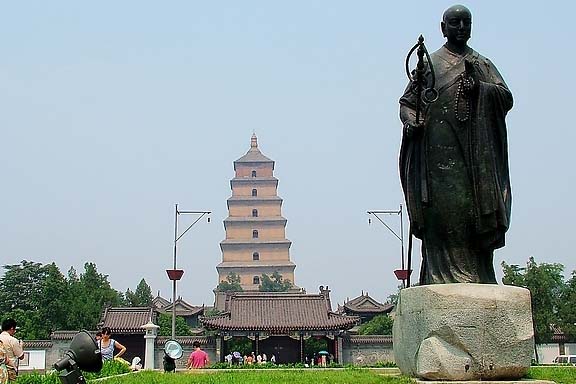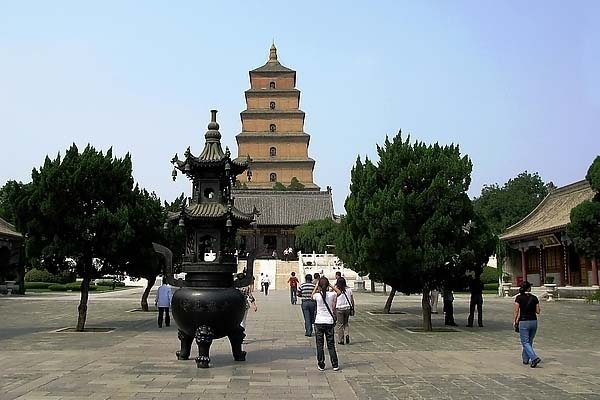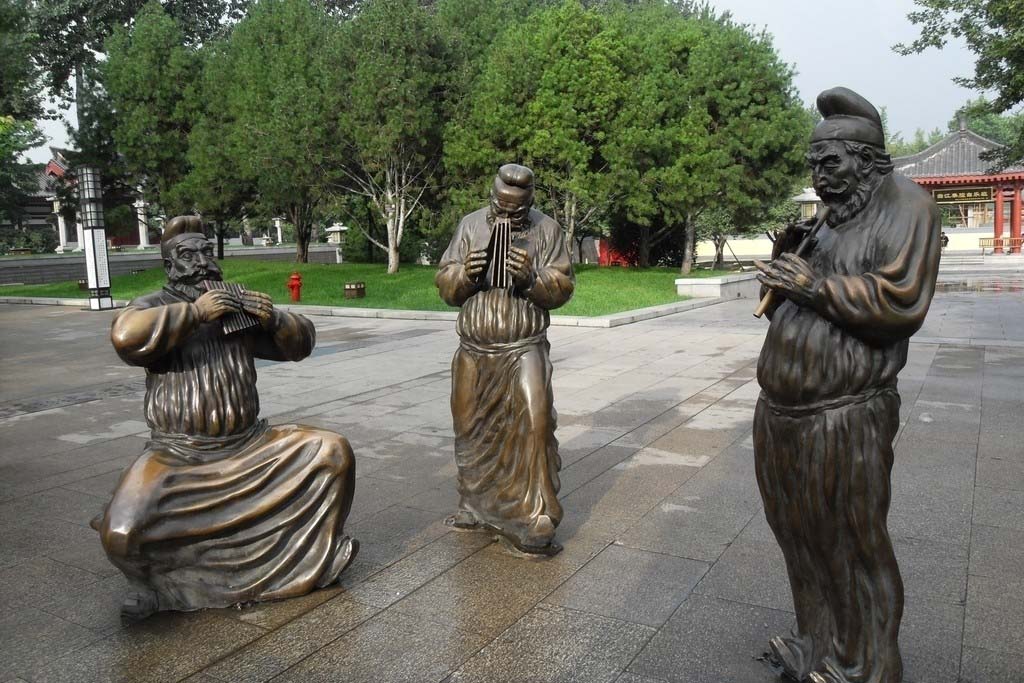Home > Attractions >
Big Goose Pagoda
As one of the well-known landmark of Xi'an, located in the south of the city wall is the brick Big Wild Goose Pagoda in the Temple of Great Maternal Grace (Ci'en Si) complex, and it was built in AD 648 by Tang emperor Gaozong as an act of filial piety to honor his mother. The temple was destroyed after the fall of the Tang dynasty and the present buildings mainly from the Qing dynasty, have been recently renovated.
Introduction of Big Wild Goose Pagoda:
As the saying goes: 'one is not deemed as having been in Xi'an without paying a visit to Big Wild Goose Pagoda'. Big Wild Goose Pagoda have been regarded as a symbol of the Xi'an city. It was built in AD 652, the pagoda has a 16. 4-foot-high (5 m) square base and reaches 212 feet(64.5 m) in height. It was built to house and protect Buddhist scriptures collected by Xuan Zang, a Buddhist monk who spent an epic 17 years traveling to India and back gathering them and an equal amount of time translating them. His journey has been immortalized in the fiction of Great Tang Records on the Western Region, one of China's most important literary works.
Xuanzang's Contribution to Buddhism:
Master Xuanzang have translated many Buddhist sutras and promoted Buddhist Dharma in Da Ci'en Temple for 11 years, and he also founded the Buddhist "Xiangwei Zhizong", which made Da Ci'en Temple be the ancestral court of the Buddhist "Xiangzong". During this period, the Master personally supervised the construction of the Great Wild Goose Pagoda in order to worship the statues and relics that were invited back from India, which is the great contributions to the Chinese Buddhism.
Small Wild Goose Pagoda
15-storied Small Wild goose Pagoda, built in the 1st year of the emperor TangZhong-zong’s reign (i.e. 707), being 1300 yeaars old, 45m in height nowadays, known for its of top, lies inside the Jianfu Temple. The densely covered caves are taken in its architecture. The two Wild Goose Pogodas set off each other to advantage. The arched door-heads of both south and north entrances are enchased with lapidarian weeds, flower patterns and intellectual donor’s images, the workmanship is exquisite.
The Building Structure of Big Wild Goose Pagoda & Nearby attractions :
Nowadays, the Dacien Temple was built in the Ming Dynasty on the basis of the original "West Pagoda Courtyard", while most of the existing palaces were built in the Qing Dynasty. The main buildings on the central axis of the monastery are Daxiong Palace, Fatang, Dayan Pagoda and Xuanzang Sanzang Court. Among them, the Buddhist relics and the parietal bones of Master Xuanzang worshipped in Dayan Pagoda and Xuanzang Sanzang Court respectively are the silk treasure in Dacien Temple, Inside the tower, the wooden stairs spiral up, and you can watch in distance by the railings out of a door on both sides of each floor. The whole building is grand and magnificent with streamlining and steady style, harmonious and appropriate proportion as well as solemn and antique tone as the well-preserved pavilion tower. On top of the tower, you can overlook the whole ancient city Xi an, which is quite worth to visit.
In the east of the central axis of the monastery is the pagoda garden. There are nine pagodas in the garden, and the Buddha relics have been worshipped in the monastery since the Qing dynasty.
In addition, there are square in the South and north of Dacien Temple, and some well-known scenic spots such as Shaanxi Museum and Tang Paradise.
When is the best time to visit?
Every year from March to May (spring blossoms and pleasant climate), September and October (autumn high, melon and fruit fragrance) are the best time to visit the Big Wild Goose Pagoda.
Travel tips of Wild Big Goose Pagoda:
1. There will be a huge crowds of people, who would like to watch the music fountains in the evening, if you want to go to the North Plaza of Dayan Pagoda to see the night scene of music fountains in the evening, you'd better arrive there early.
2. There will be some adjustments every year, especially during the off-peak season of the scenic spot, and the exact time can be consulted by telephone at that time. Telephone Number: 029-85521890
How to get there?
1. Travelers can take bus No. 5, 19, 21, 22, 23, 24, 27, 30, 34, 41, 44, 224, 237, 242, 400, 401, 408, 500, 501, 521 or sightseeing bus to Wild Goose Pagoda stop.
2. Tourists can take taxis from the railway station, usually it will costs 15 yuan to arrive, which is quite economy.
The admission fees: 50 RMB
Ticket for climbing the Wild Big Goose Pagoda: 30 RMB
Opening Time:
Peak season: 1st March to 31st October (8.00 AM to 6.30 PM)
Off season: 11th January to 29th February (8.00 AM to 6.00 PM)
Musical fountain:
Monday to Friday: 12.00 AM to 9.00 PM, ( Every Tuesday, the fountain dance equipment have to routinely overhauled, so the 12 o'clock fountain show is off ).
Weekend: 12.00 AM to 6.00 PM
Related Articles & Posts
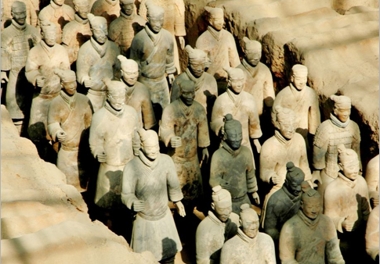 Terracotta Warriors
Terracotta Warriors 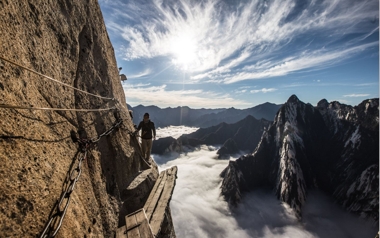 Huashan Mountain
Huashan Mountain
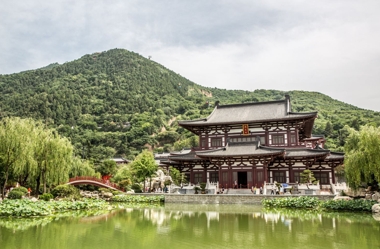 Huaqing Hot Spring
Huaqing Hot Spring 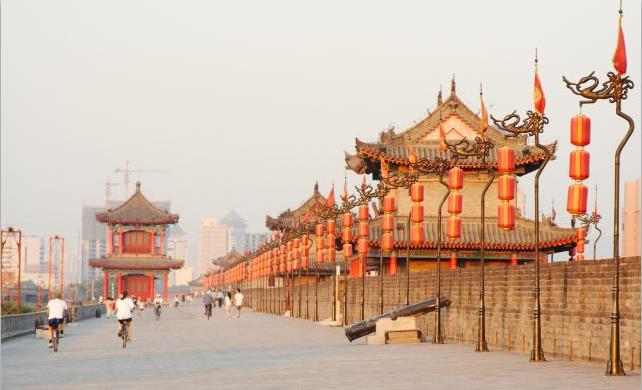 Xi'an City Wall
Xi'an City Wall
Recommended Xi'an Tours
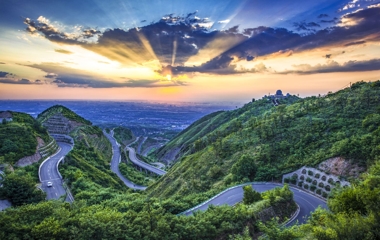 Silk Road Luxurious Tour
Silk Road Luxurious Tour 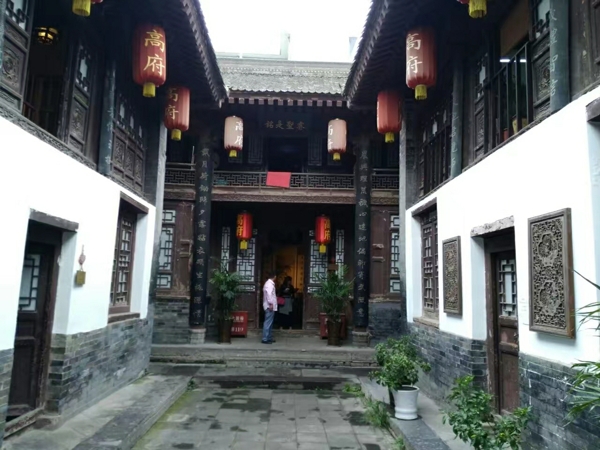 Silk Road Culture Exploration Tour
Silk Road Culture Exploration Tour
 Silk Road in-depth Tour
Silk Road in-depth Tour  Silk Road Classic Tour
Silk Road Classic Tour
Introduction of Big Wild Goose Pagoda:
As the saying goes: 'one is not deemed as having been in Xi'an without paying a visit to Big Wild Goose Pagoda'. Big Wild Goose Pagoda have been regarded as a symbol of the Xi'an city. It was built in AD 652, the pagoda has a 16. 4-foot-high (5 m) square base and reaches 212 feet(64.5 m) in height. It was built to house and protect Buddhist scriptures collected by Xuan Zang, a Buddhist monk who spent an epic 17 years traveling to India and back gathering them and an equal amount of time translating them. His journey has been immortalized in the fiction of Great Tang Records on the Western Region, one of China's most important literary works.
Xuanzang's Contribution to Buddhism:
Master Xuanzang have translated many Buddhist sutras and promoted Buddhist Dharma in Da Ci'en Temple for 11 years, and he also founded the Buddhist "Xiangwei Zhizong", which made Da Ci'en Temple be the ancestral court of the Buddhist "Xiangzong". During this period, the Master personally supervised the construction of the Great Wild Goose Pagoda in order to worship the statues and relics that were invited back from India, which is the great contributions to the Chinese Buddhism.
Small Wild Goose Pagoda
15-storied Small Wild goose Pagoda, built in the 1st year of the emperor TangZhong-zong’s reign (i.e. 707), being 1300 yeaars old, 45m in height nowadays, known for its of top, lies inside the Jianfu Temple. The densely covered caves are taken in its architecture. The two Wild Goose Pogodas set off each other to advantage. The arched door-heads of both south and north entrances are enchased with lapidarian weeds, flower patterns and intellectual donor’s images, the workmanship is exquisite.
The Building Structure of Big Wild Goose Pagoda & Nearby attractions :
Nowadays, the Dacien Temple was built in the Ming Dynasty on the basis of the original "West Pagoda Courtyard", while most of the existing palaces were built in the Qing Dynasty. The main buildings on the central axis of the monastery are Daxiong Palace, Fatang, Dayan Pagoda and Xuanzang Sanzang Court. Among them, the Buddhist relics and the parietal bones of Master Xuanzang worshipped in Dayan Pagoda and Xuanzang Sanzang Court respectively are the silk treasure in Dacien Temple, Inside the tower, the wooden stairs spiral up, and you can watch in distance by the railings out of a door on both sides of each floor. The whole building is grand and magnificent with streamlining and steady style, harmonious and appropriate proportion as well as solemn and antique tone as the well-preserved pavilion tower. On top of the tower, you can overlook the whole ancient city Xi an, which is quite worth to visit.
In the east of the central axis of the monastery is the pagoda garden. There are nine pagodas in the garden, and the Buddha relics have been worshipped in the monastery since the Qing dynasty.
In addition, there are square in the South and north of Dacien Temple, and some well-known scenic spots such as Shaanxi Museum and Tang Paradise.
When is the best time to visit?
Every year from March to May (spring blossoms and pleasant climate), September and October (autumn high, melon and fruit fragrance) are the best time to visit the Big Wild Goose Pagoda.
Travel tips of Wild Big Goose Pagoda:
1. There will be a huge crowds of people, who would like to watch the music fountains in the evening, if you want to go to the North Plaza of Dayan Pagoda to see the night scene of music fountains in the evening, you'd better arrive there early.
2. There will be some adjustments every year, especially during the off-peak season of the scenic spot, and the exact time can be consulted by telephone at that time. Telephone Number: 029-85521890
How to get there?
1. Travelers can take bus No. 5, 19, 21, 22, 23, 24, 27, 30, 34, 41, 44, 224, 237, 242, 400, 401, 408, 500, 501, 521 or sightseeing bus to Wild Goose Pagoda stop.
2. Tourists can take taxis from the railway station, usually it will costs 15 yuan to arrive, which is quite economy.
The admission fees: 50 RMB
Ticket for climbing the Wild Big Goose Pagoda: 30 RMB
Opening Time:
Peak season: 1st March to 31st October (8.00 AM to 6.30 PM)
Off season: 11th January to 29th February (8.00 AM to 6.00 PM)
Musical fountain:
Monday to Friday: 12.00 AM to 9.00 PM, ( Every Tuesday, the fountain dance equipment have to routinely overhauled, so the 12 o'clock fountain show is off ).
Weekend: 12.00 AM to 6.00 PM
Related Articles & Posts
 Terracotta Warriors
Terracotta Warriors  Huashan Mountain
Huashan Mountain  Huaqing Hot Spring
Huaqing Hot Spring  Xi'an City Wall
Xi'an City Wall Recommended Xi'an Tours
 Silk Road Luxurious Tour
Silk Road Luxurious Tour  Silk Road Culture Exploration Tour
Silk Road Culture Exploration Tour Silk Road in-depth Tour
Silk Road in-depth Tour  Silk Road Classic Tour
Silk Road Classic Tour 
